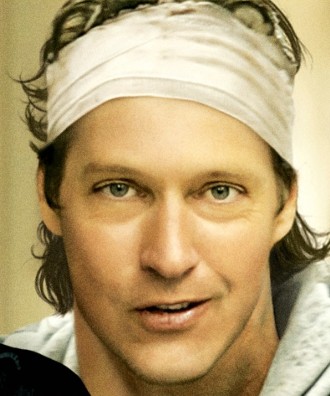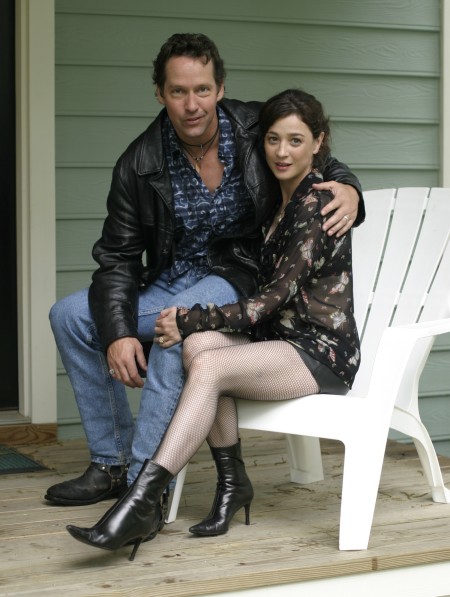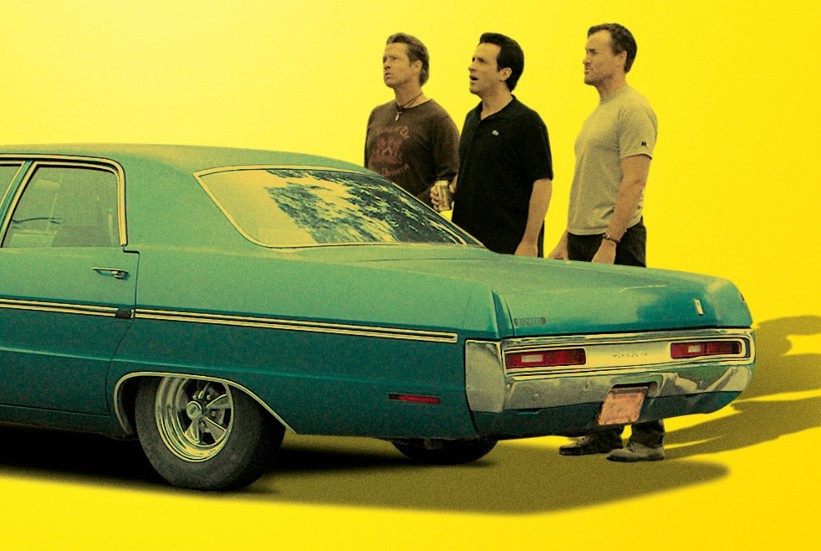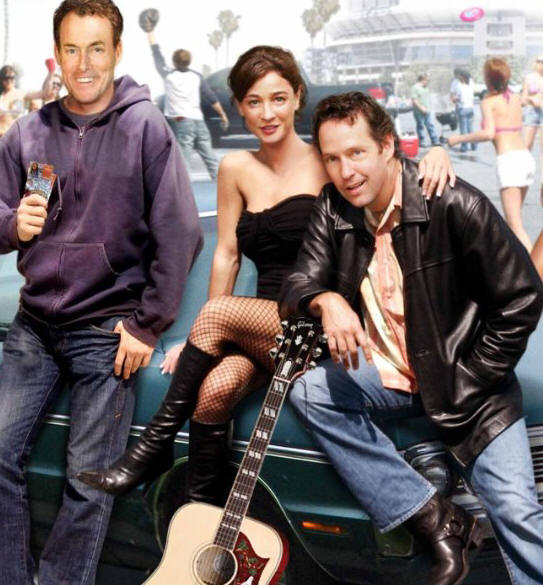As so often
happens, the germ of the idea for actor D.B. Sweeney’s writing and
directing debut Two Tickets to Paradise came from a real life
experience. In fact, it was a drunken road trip down to Myrtle
Beach, South Carolina with his brother that set the wheels in motion
in his head.
At the time,
Sweeney was already a well-known actor, starring in such films as
The Cutting Edge, Eight Men Out, Gardens of Stone, Memphis Belle
and Roommates. His father had recently remarried and their
new step-mother had invited the Sweeney boys to come
down for a visit. Problem was, Sweeney and his brother
didn’t get along with the woman at all.
“He was married
to my mom for over twenty years and then he remarried,” Sweeney
recalls. “And I hated the woman he remarried. I try not to use
that word too often, but…,” he trails off.
Sweeney and his
brother had spent just a little time there and they were miserable.
They tried to be good sports, but eventually they couldn’t handle it
any longer. They needed to get away and blow off a little steam.
“So my brother
and I go out and we kind of have a couple beers – or a couple of
thirty beers – and we buy fireworks,” Sweeney continues. “We got
this great rental car and we turn the back wheel wells of the car
into coolers, because that was easier and cheaper than buying an
actual cooler. And it made a great sound when you hit the brakes –
just ice in both wheel wells and then beers everywhere. Then we had
about 200 bottle rockets. We just figured we would pick a color of
cars and start firing the bottle rockets at that color cars.”
Okay, Sweeney
acknowledges in hindsight, it wasn’t that smart an idea. But that
was their plan for the evening. Sweeney and his brother sat
drinking at the side of the road and dive-bombing passing cars.
However, as so often happens when the plan isn’t too well thought
out, it did not work out quite the way they had hoped – if they’d
even taken the time to think out what might happen.
“The Myrtle Beach
police didn’t agree with the plan,” Sweeney says. “They interceded
and arrested us. As they were bringing us into the police station,
the guy says, ‘What would lead two seemingly normal guys to drive
around with a bunch of open beers in your car and fire bottle
rockets at other cars?’ I said, you know what? My dad just got
remarried and my stepmother is a bitch. The cop stops in his steps
and he goes, ‘You know what? So is mine.’” Sweeney laughs at the
memory. “We spent about twenty minutes talking about our respective
stepmothers. He undid the cuffs and let us go.”
This brush with
the law got Sweeney thinking of all the stupid jams that otherwise
completely rational people could get themselves into just out of
desperation or boredom or anger or sheer hopelessness. He knew that
there was an interesting story in this dichotomy, so he got together
with a fellow actor, Brian Currie (The Game Plan), to work on
his first script. Sweeney took this opportunity to heart, also
directing and financing the film.
 This
DIY aesthetic was different for Sweeney, who has previously starred
in major motion pictures listed above as well as spending most of
the last decade appearing in some of the biggest shows on television
– including all three CSI franchises, 24, Criminal Minds,
House MD, NYPD Blue and Once &
Again. However, he was passionate about getting his film made
and seen.
This
DIY aesthetic was different for Sweeney, who has previously starred
in major motion pictures listed above as well as spending most of
the last decade appearing in some of the biggest shows on television
– including all three CSI franchises, 24, Criminal Minds,
House MD, NYPD Blue and Once &
Again. However, he was passionate about getting his film made
and seen.
Beyond the fact
that it was a great professional challenge, Sweeney felt a huge
connection to the highly autobiographical story he had written
(originally entitled Dirt Nap) about three childhood friends
who are reaching their 40s and are each at life crossroads and get a
chance for a road trip to see the college football championship
bowl. Of course, with the group’s normal luck, there are three guys
and only two tickets.
Sweeney likes the
idea of kids growing up together and staying friends. Now, decades
after making his life in Hollywood, he is still in touch with a few
close childhood friends from his Staten Island, NY home.
“I have my friend
Scott Lashier,” Sweeney explains. “He did 22 years in the Marine
Corps and now he’s retired. We played Little League together. Kyle
Stanford sells bonds or something down on Wall Street. He’s a good
guy to meet in any kind of bar called O’Looney’s. Who else? Bob
Sickle is another guy I played Little League with. So, yeah, I’ve
got three guys that’s I’m in touch with from way back, that far in
my life. John McGinley and I went to NYU together in the early
80s. That was really why I wanted him in the movie, because we
already had that kind of bond.”
John C. McGinley
who is best known lately for his role on the sitcom Scrubs,
plays Mark, the local hero athlete who is now a degenerate gambler.
His mounting debts are poisoning his relationship with his
supportive wife (played by Janet Jones Gretzky.) Sweeney plays
Billy McGriff, a former local rock star who has now settled into a
life driving a delivery truck for Coors and just has learned that
his wife (played by Sweeney’s Cutting Edge co-star Moira
Kelly) is having an affair. The final friend is Jason (played by
comic actor Paul Hipp), the brains of the three who is now
desperately single, living with his parents and toiling in a
dead-end job at Office Depot.
“Brian Currie,
who I wrote the movie with, almost every event in the movie either
happened to him or me,” Sweeney says. “But my character is
McGinley’s character, more or less. Obviously, I didn’t turn out to
be a waste-product degenerate gambler or whatever, but I had a
sports background that didn’t work out and that was a big problem
for me for a while after that – and for a lot of athletes –
transitioning into whatever the rest of your life is going to be.
That would be the biggest thing. The character that I played was
the character I always wanted to play. I always wanted to be the
goofy guy who only cared about his guitar.”
Despite the fact
that they were old friends, Sweeney admits that
McGinley was not the first
choice for Mark – though he is very happy with the way it all came
out.
“We sort of had
Alec Baldwin-meets-John Kennedy, Jr. plus too many twelve packs of
beer [in mind],” Sweeney admits. “When we got down to making the
movie, Alec Baldwin didn’t return our call, plus he’d gotten too
fat. But otherwise, John McGinley was very close. He comes from
very patrician stock in New Jersey. His father was a big Wall
Street guy. John is a guy who was destined for success at a very
young age. I think that’s what this character has. He was the
can’t-miss kid – and somehow he missed. That’s the jumping off
point of the story.”
 Another
old friend that Sweeney did not expect to get onboard was Kelly, who
played the spoiled figure skater who fell for Sweeney’s tough-guy
hockey player in the figure skating romance The Cutting Edge.
In fact, had he known that she would be a part of the film, he
admits, he would have given her character a bit more to do.
Another
old friend that Sweeney did not expect to get onboard was Kelly, who
played the spoiled figure skater who fell for Sweeney’s tough-guy
hockey player in the figure skating romance The Cutting Edge.
In fact, had he known that she would be a part of the film, he
admits, he would have given her character a bit more to do.
“I always hoped
Moira and I would work together again,” Sweeney says. “We never
found a script. The Cutting Edge sequel scripts were
terrible. When this thing came around, she was right at the top of
my list, either for that role or for McGinley’s wife in the movie.
It turns out she was living in Wilmington, North Carolina, where we
were filming the movie. The crew of One Tree Hill – a lot of
their crew ended up to be my crew on the movie, so I was able to get
a hold of Moira. She immediately said yes and came down. Had I
known with more lead time that I was going to get Moira, we would
have had much more scenes together, believe me. I think there would
have been a scene of us at a skating rink. I don’t know if we would
have been skating, but we would have been at the rink.”
Sweeney decided
early on to give the movie a small-town feel. The guys were
supposed to be from Chalfont, Pennsylvania, a town about an hour
outside of Philadelphia. Sweeney is from Staten Island, New York
and his co-writer grew up outside of Boston, but this rural setting
was very important to them.
Sweeney chose his
characters’ hometown for a simple reason: “My cousins are from
Chalfont,” he explains. “And my favorite uncle, dearly departed,
Jack McCullen, he was from Chalfont. His kid’s there. The other
thing is my co-writer is from Peabody, Massachusetts, which is just
outside of Boston, and like you said I’m from Long Island. We just
felt like there’s been plenty of Boston movies and plenty of New
York movies. We really didn’t want to make it that specific. We
wanted it to be more of a regional thing. That’s why we thought
that Pennsylvania more captures that sort of… not rust belt, but
blue collar, northeast, old school kind of vibe we were looking
for.”
However, most of
the scenes of Chalfont were filmed down south – right in the area
where years before Sweeney had taken that apocryphal road trip. In
fact, that trip led to one of the funnier scenes in Two Tickets
to Paradise, where the drunken buddies mistakenly burn down a
(fictional) museum dedicated to Wheel of Fortune
letter-turner Vanna White.
The whole idea
came when on the bottle rocket trip years ago. As they were driving
in, Sweeney had seen a sign which read: “North Myrtle Beach, home of
Vanna White.” Sweeney found that amusing and stored the idea away.
“Myrtle Beach,
they had the Civil War come through here,” Sweeney says. “They had
so much American history in this part of the country. Yet, their
favorite son is Vanna White. Wouldn’t you think it would be ‘The
home of General Beauregard’ or something? It just made such an
impression on me. With that said, I love Vanna White. I have
watched Wheel of Fortune not for the prizes many times. No
knock on her, I just thought it was kind of funny. So I thought
what if you take the idea a little further and there is like an Abe
Lincoln’s cabin? Like her birth home has been preserved as an
historic monument? I thought that would be funny. Then, of course,
add drunken guys to fire bottle rockets at it and burn it down.”
 That
was the origin of the scene, but there is a big difference
between writing
a funny scene about burning down a Vanna White monument and actually
being able to do so. First of all, on a low budget independent
film, it is rather difficult to actually be able to afford to burn
down a house. Also, of course, Sweeney needed to get White’s
permission to do it – after all her name and likeness was being
used. Well, sort of her likeness. Because of the limited budget,
Sweeney got a local art college to have a contest creating a Vanna
White statue. They received only four entries – and frankly none of
them looked a thing like Vanna. However, Sweeney used the closest,
figuring it would be even funnier to have a statue that didn’t
really look like it’s subject. However, there was still the task of
getting White to go along with it all.
That
was the origin of the scene, but there is a big difference
between writing
a funny scene about burning down a Vanna White monument and actually
being able to do so. First of all, on a low budget independent
film, it is rather difficult to actually be able to afford to burn
down a house. Also, of course, Sweeney needed to get White’s
permission to do it – after all her name and likeness was being
used. Well, sort of her likeness. Because of the limited budget,
Sweeney got a local art college to have a contest creating a Vanna
White statue. They received only four entries – and frankly none of
them looked a thing like Vanna. However, Sweeney used the closest,
figuring it would be even funnier to have a statue that didn’t
really look like it’s subject. However, there was still the task of
getting White to go along with it all.
“A friend of mine
who I play golf with, Steve Mosko, works for Sony Pictures,” Sweeney
says. “Sony Television syndicates Wheel of Fortune. He said
he’ll get me an introduction. I go on the set of Wheel of
Fortune and I’d read on the internet that Vanna White likes
White Castle hamburgers. I thought I’ve only got ten minutes with
her, but I’ve got to make an impression. So I brought the White
Castle hamburgers from the grocery freezer counter. I had them in a
shopping bag with a script. I said, listen, Vanna, I know you don’t
have time to read my script, but I want you to have lunch with me.
I took out the frozen hamburgers. She thought that was very
charming and she agreed to do it. That’s how I got her permission.
She then read the script and was a very good sport about it. Even
though she was a little bit the butt of a joke, she was also being
celebrated.”
In fact, White
even agreed to do a cameo appearance at the big Bowl game later in
the film. So Vanna White was on board. They still needed a house
which they could burn down. Sweeney drove all around the
Wilmington, North Carolina area (where much of the film was made).
Finally, one day he came across an area where the state was widening
the road. They were going to knock down a bunch of old structures,
including one that Sweeney knew would be perfect for the film.
“I went up to the
guy in the Land Mover that was getting ready to knock all these
houses down and said can you stop?” Sweeney says. “Don’t knock that
house down for five weeks, okay? I need to shoot it in a movie. He
said some things that you can’t really say on a family website.
But, it was basically no, with a lot more syllables. I went and
drove around more. I was like, I know the answer to this is
somewhere around here. The next town over was Dublin, North
Carolina. I thought here’s a great time to be named Sweeney. I go
to the fire house. There’s a bunch of Irish firemen there. I tell
them the story of making the movie and what I need. Within a half
an hour, they had called the North Carolina Department of
Transportation and had gotten them to call off the Land Mover. They
agreed to turn the filming of the burning of this house down into a
fire training exercise, so it wouldn’t cost me anything. They would
come over with a fire truck and do controlled burns on the house and
then put it out when it was over – and gave me the fire truck for a
drive by, to boot.”
 Sweeney
was happily surprised at how many people would help him out with the
movie. For example, Coors Beer loaned him a truck and gave him beer
to use in the film. Office Depot allowed him to film in their
store. Local carnivals and bars also allowed the
filming.
Sweeney
was happily surprised at how many people would help him out with the
movie. For example, Coors Beer loaned him a truck and gave him beer
to use in the film. Office Depot allowed him to film in their
store. Local carnivals and bars also allowed the
filming.
Another huge deal
for Sweeney was the soundtrack. He went into the filming with very
specific songs in mind by huge artists like Bruce Springsteen, Bob
Dylan, Dire Straits – and he was happily surprised that he was able
to license almost all of them, mostly at greatly reduced prices.
“This is my first
movie, obviously, as a director and as a producer,” Sweeney says.
“A lot of people cautioned me, ‘Look, when you mix your movie
together, be realistic about the music you’re going to get.’
Because if you put a bunch of great songs in there and you edit your
movie accordingly, your movie might work really well, but it’s
working mainly because of these songs you’re never going to get.
Or, that’s really helping the movie work. In my case, the songs I
put in there generally were the songs I wanted and I loved. I got
all my temp songs. So it was really, really great. Except the one
that got away was U2. The band agreed to give me a song, but then
Island Records dragged their feet. At a certain point, I had to
lock the movie’s soundtrack and I couldn’t wait anymore.”
Another song that
did not make the film was more of an afterthought. As noted before,
the original title to the film was Dirt Nap. When Sweeney
decided to switch the title to Two Tickets to Paradise, he
toyed with the idea of licensing the Eddie Money song of the same
title.
“When we changed
it to Two Tickets to Paradise, I immediately looked into
getting that song,” Sweeney says. “I never got to Eddie Money the
way I got to Springsteen and Dylan’s people. I think I just got to
a lawyer or something and they weren’t helpful. I just thought
we’ve got enough music. We’ve got Springsteen and Dylan and Dire
Straits. It’d be great to have the Eddie Money song, but I’m not
going to lose any sleep over it.”
However, Sweeney
was getting a learning experience on the minutiae of
filmmaking. The smallest things turned out to be a negotiation –
which was interesting to Sweeney, but also sometimes a little
overwhelming since he was often the man trying to get everything
straightened out. Even the colleges that were going to be playing
in the Bowl game that the guys were journeying to became a bit of a
dilemma. Though the final score of the game was just barely
acknowledged in the film – it was shown briefly in a newspaper
clipping – most of the colleges that were approached refused to have
their team be on the losing side.
“In the original
script, Texas beats USC 33-30, which is the actual score in the Rose
Bowl where Texas won the National Championship,” Sweeney says. “I
was going around the colleges the year before and USC would not
agree to lose the fictional game. I went around to a lot of other
colleges that you might think would be in the championship game, and
of all of those colleges, only Marshall would agree to lose in the
big game.”
The actual
filming of the Bowl Game – done around a real college football game
(featuring neither Texas nor Marshall, though) – was also a bit of
guerilla filmmaking. However, Sweeney got some help from an
unexpected source – hockey great Wayne Gretzky. Gretzky’s actress
wife Janet Jones Gretzky played McGinley’s wife in the film – and
his son and mother-in-law played those same roles in McGinley’s
family. Gretzky was often around the filming – he even did a few
voiceover lines, however his actual presence in scenes would have
been too much of a distraction, so he stayed off camera.
Nonetheless, the Great One was able to almost single-handedly round
up hundreds of extras for the bowl game sequence.
“He was a great
morale-builder for the crew, especially in one big scene we did in
San Diego,” Sweeney says. “He actually helped us to collect
extras. We’re shooting a football stadium scene and the game at the
stadium – San Diego State University against UCLA, which is San
Diego State maroon, UCLA light blue. In our movie it is Marshall
green against Texas burnt orange. We needed it to look like there
were tens of thousands of people come to see that game. At game
time, around four o’clock, as the people were streaming into the
stadium, Gretzky was standing where they were coming through with a
case of Coors Light and a t-shirt. I got my brother-in-law to make
up 800 Texas t-shirts and 800 Marshall t-shirts. Gretzky would
stand there like a popcorn salesman and, ‘Hey, if you put this
t-shirt on and stand here, I’ll give you a free beer.’ People would
be like, ‘Isn’t that Wayne Gretzky?’ He collected hundreds of
people who were just curious [because] it was Wayne Gretzky. He was
so gracious. Took pictures with people, signed everything, he was
just great. Without him, that scene would have been much more
sparsely populated.”
Now, a few years
after the filming has been done, Two Tickets to Paradise is
being released on DVD a second time (it was briefly released in
2008). The film has become a favorite at film festivals. And it
was a great learning process for its maker – who is back to a busy
acting schedule while he contemplates a follow-up film.
As an actor,
Sweeney realizes, he has received an insight in filmmaking that most
first-time directors never have had. He has done films with some of
the legendary directors in Hollywood, including Francis Ford
Coppola, Spike Lee, Peter Yates, John Sayles and Sidney Lumet.
Through working with these directors, he has come to a realization
about filmmaking – a realization that shows up in his own directing
technique.
“All those guys,
they don’t do a lot of directing,” Sweeney explains. “They
basically hire the best cameraman. They hire the best actors. They
make sure they are in the best locations to film. They make sure
the script is in the best possible shape. Then they let people do
their jobs. Whenever something’s not going right, they may tweak it
or fix it a little bit, but all those great directors you talk
about, they almost never raise their voice. They never scream.
Things proceed as they are supposed to proceed. They have the
respect of letting people do their jobs. The amateur directors tend
to scream and yell and try to prove to everybody that they are
Francis Coppola or Sidney Lumet or Peter Yates. That’s where they
go wrong, I think.”
This is a
tactical error that D.B. Sweeney is sure never to make.
Email
us Let us know what you
think.